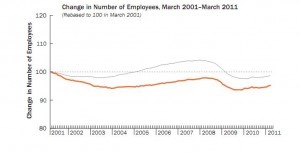Smaller, Fewer is Not Better
While the rest of the US created jobs after the 2001 recession, Massachusetts shrank. Understanding why is important if we want to avoid a ‘jobless recovery’ from the most recent recession.

The above chart shows US jobs (thin black line) versus MA jobs (bold red line) starting in 2001. What you see is both dropping in response to the recession but the US economy comes back by 2005 and creates net new jobs. The Massachusetts economy never comes back far enough to reach early 2001 levels.
Two connected factors explain a significant portion of our stagnation – Massachusetts is failing to create new businesses at the same rate it did in the ‘90s and the new businesses we manage to create are much smaller in size.
Pioneer’s latest study, The Big Shrink, seeks to understand how the dynamics of firm size have changed. Average establishment size has dropped from 16 employees in 1990 to 9.7 employees by 2007.
This decline has several causes. Large establishments in Massachusetts are disappearing, particular branches of over 100 people. Headquarters have actually grown in average firm size over the period studied. Unfortunately, we lost an astounding 5,000 of them from 1990 to 2007.
The most important changes have occurred at standalone, single-location firms that make up the vast majority of establishments in the state.
The number of standalone businesses has increased by almost 150,000 establishments over the seventeen year period. But most of that growth is from single-person or non-employer service businesses, particular business services. That has resulted in drop of average firm size at standalone companies from 8.4 to 5.5 employees.
A job creation dynamic that results in fewer, smaller businesses is incompatible with long-term economic growth. What is stopping Massachusetts establishments from growing and, in the process, hiring more people?


